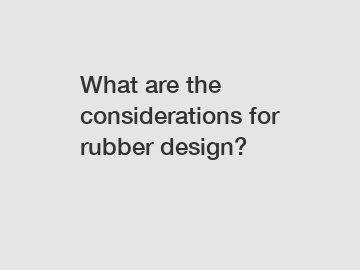Rubber design is an important aspect of various industries, from automotive to medical equipment. When designing rubber components, there are several key considerations that engineers and designers need to keep in mind to ensure optimal performance and durability. In this article, we will explore the key factors that need to be taken into account when designing rubber components.
Material Selection.
One of the most critical considerations in rubber design is material selection. The type of rubber used will have a significant impact on the performance and longevity of the component. Factors such as temperature resistance, chemical compatibility, hardness, and flexibility all need to be carefully considered when choosing the right material for the application. Natural rubber, synthetic rubber, silicone rubber, and fluorocarbon rubber are just a few of the options available, each with their own unique properties and strengths.

Design Specifications.
Once the material has been selected, designers need to carefully consider the specifications of the component. This includes dimensions, tolerances, and potential stress points. Factors such as compression set, tensile strength, and tear resistance need to be taken into account to ensure that the component will perform as intended under all conditions. Computer-aided design (CAD) software can be used to create precise drawings and simulations to test the design before manufacturing begins.
Environmental Factors.
Rubber components are often exposed to a wide range of environmental factors, including temperature fluctuations, exposure to chemicals, and UV radiation. These factors can all impact the performance of the rubber and lead to premature failure if not properly accounted for in the design. Special additives may need to be incorporated into the rubber compound to enhance its resistance to these environmental factors and prolong its lifespan.
Manufacturability.
Another important consideration in rubber design is manufacturability. Designers need to ensure that the component can be manufactured using the chosen production methods, such as injection molding, compression molding, or extrusion. Mold complexity, parting lines, and draft angles all need to be taken into account to ensure that the component can be produced efficiently and cost-effectively. Prototyping and testing are often used to identify any potential manufacturing issues early in the design process.
Testing and Quality Control.
Once the design has been finalized and the component has been manufactured, testing and quality control are essential to ensure that the rubber component meets the necessary performance standards. Tensile testing, compression testing, and hardness testing are just a few of the tests that may be conducted to verify the integrity of the component. In addition, visual inspection and dimensional measurement are used to check for any defects or deviations from the design specifications.
Conclusion.
In conclusion, rubber design is a complex process that requires careful consideration of material selection, design specifications, environmental factors, manufacturability, and testing. By taking these key factors into account, engineers and designers can create rubber components that meet the necessary performance standards and provide reliable service in a wide range of applications.
If you have any questions about rubber design or need assistance with your rubber component design, please do not hesitate to contact us. Our team of experts is here to help you with all of your rubber design needs.
Are you interested in learning more about buy colored o rings, special shapes rubbers factory, customized rubber parts? Contact us today to secure an expert consultation!





Comments
0